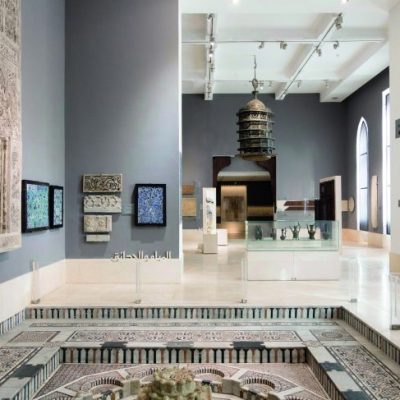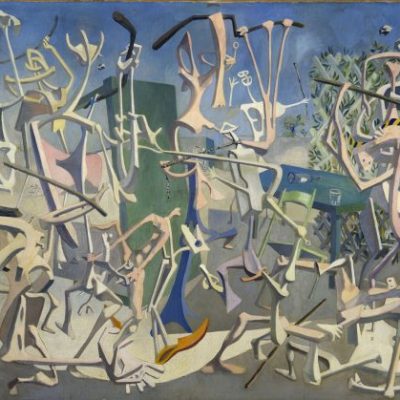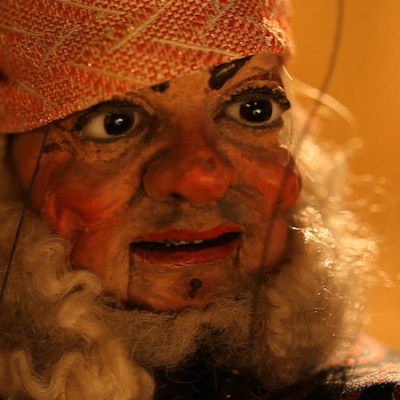In a shabby alley, less than half a mile away from Tahrir Square in Cairo, the Townhouse Gallery has for the past 20 years acted as a cornerstone of contemporary art in Egypt. This summer, The Mosaic Rooms in London is holding a retrospective of the space entitled ‘What do we mean, here we are?’ The works of established figures such as Mona Hatoum, Lara Baladi and Wael Shawky sit side by side with those of early-career artists including Islam Shabana, Malak Yacout and Khaled Kaddal. The result charts the transformation of artistic production and curatorial practices at the gallery over the last 20 years, which has evolved from a traditional white-cube model to a community arts centre embedded in the social tissue of its surroundings.
The exhibition opens with these environs. Model Citizens by Dutch artists Wouter Osterholt and Elke Uitentuis is a scale model that reproduces the downtown Antikhana neighbourhood where Townhouse is located – including the two buildings of the gallery, coffee shops, mechanical workshops, greengrocers and a derelict Ottoman palace. It was produced in collaboration with local artists while the duo completed a residency at Townhouse in 2008 and subsequently displayed there. People who lived in the area were asked to consider what they would like to change in their neighbourhood, and the model was modified accordingly.
Installation view of ‘What do we mean, here we are?’ at The Mosaic Rooms, London, 2018. Photo: Andy Stagg. Courtesy The Mosaic Rooms

In its early years, Townhouse was a regular participant in the international art-world circuit, working with artists and organisations around the world. Cairo Crossroads (2007) by Egyptian–German artist Susan Hefuna, also on view in The Mosaic Rooms, is a 100-minute video of the lane shot from the gallery’s balcony. It was part of the Crossroads series, shot at junctions in Cairo, Frankfurt, London and elsewhere, exploring the movement of people within a small cross-section of a city. The work was later screened at the Serpentine Gallery, while Hefuna’s videos of the Edgware Road in London were presented in Cairo.
In December 2015 the gallery was shut down after a raid by the government. It briefly reopened a few months later, before the main building partially collapsed in April 2016. Thereafter the authorities tried repeatedly to demolish the building, which they alleged was unsafe. For many in the art world the symbolism of the collapse was inescapable. But as Townhouse’s director William Wells recently stated, it was important to break from this symbolism – ‘it was the building collapsing and not the end of Townhouse’. As an Egyptian who has been living abroad since 2012, I remember friends calling to tell me of the efforts by staff, local residents and friends of Townhouse to fight the demolition. It was eventually halted, and a funding campaign resulted in its rebuilding. The gallery’s main space re-opened last April.
In the interim, Townhouse occupied the Factory, a sprawling, warehouse-like space at street level. This temporary relocation was a success: it strengthened ties with the local community, and brought a new kind of visitor, the curious passer-by, through the gallery’s doors. Wells told me how a younger audience of under 30s began to walk into the space to visit the exhibitions, consult books in the library and even bring in art portfolios. This audience came of age after the revolution; they are not overtly political but are engaged, anti-authoritarian and not socially conformist.
Townhouse Alley. Courtesy of Townhouse Gallery

This new audience has emerged from a shifting cultural landscape. The 2013 law restricting NGO activity and forbidding foreign funding reduced artistic activity to around a quarter of what it was in 2012. Artists and intellectuals withdrew; many left the country out of despair and alienation; others retreated to their studios in the suburbs of the city. Under stifling censorship and crackdowns on freedom of expression, the public sphere had been eroded. Public discussions, conferences and symposiums were replaced by one-to-one discussions behind closed doors. During my frequent visits home to Cairo, I tried to make sense of what was happening, but had found it hard to grasp. But since 2017 something interesting has been happening on the ground.
The work of younger artists is now often turned inwards, towards a more personal and contemplative place. Take Malak Yacout’s Dialogue with 10 Nabrawy (Townhouse’s address in Cairo) from 2018. Shown in the first exhibition in the reopened gallery, the project is a contemplation of the intimate life of the 1890s building. Yacout asks: ‘If they were permitted to speak, what memories would sites testify to; what anecdotes would they tell?’ The result is a set of handwritten texts that seem to allow the buildings can speak for themselves. Yacout studied under Shady Noshokaty, whose work The Bed (1999) is also displayed in the same room.
After its collapse, people thought that Townhouse was dormant or had shut entirely, but with events like the Mosaic Rooms exhibition, its international networks are being reactivated. When I came home to Egypt this month, as I visited art spaces and initiatives throughout the country, I felt a buzzing energy. Gypsum gallery is going strong and participating in global art fairs; Wael Shawky’s MASS Alexandria and Roznama Studio in Cairo are offering alternative educational programmes; organisations like the consultancy Art d’Égypte are working to promote Egyptian artists; and CLUSTER (Cairo Lab for Urban Studies, Training and Environmental Research) is exploring the role of art and culture in urban regeneration. Friends speak to me of renewed cultural energy and conversations. One established Egyptian artist living in London tells me she is preparing to return to Cairo, where she hopes to find inspiration for future work.
‘What do we mean, here we are?’ is at The Mosaic Rooms, London, until 15 September.


